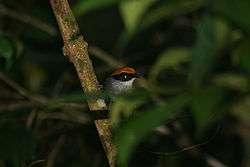Conopophaga
| Conopophaga | |
|---|---|
 | |
| Black-cheeked gnateater | |
| Scientific classification | |
| Kingdom: | Animalia |
| Phylum: | Chordata |
| Class: | Aves |
| Order: | Passeriformes |
| Family: | Conopophagidae |
| Genus: | Conopophaga Vieillot, 1816 |
| species | |
|
see text | |
Conopophaga is a genus of birds in the gnateater family. Its members are found in forest and woodland in South America.
Habitat and range
Gnateaters are birds found in the undergrowth of forest, woodland, and bamboo stands, with most species in the Amazon Basin, the Atlantic Forest, and the East Andean slopes. All are associated with dense thickets. While they are always found near the ground, seldom rising more than 1.5 m up, they also seldom travel or spend much time on the ground itself (though they do feed there; see diet).
They are round, short-tailed, and long-legged birds, about 12–18 cm (4.5–7 in) in length. They are quite upright when standing. They are sexually dimorphic, with various shades of brown, rufous, olive, white, grey and black being the dominating colours. Most Conopophaga species have a white tuft behind the eye.
Diet
Gnateaters are insectivorous as the group name implies. They feed mostly using two methods; one is to perch above the forest floor until prey is spotted, then lunge down to the ground to snatch it; having landed on the ground to snatch a prey item, it will not remain on the forest floor for more than a couple of seconds. The second method used by gnateaters is to glean insects directly from the foliage, trunks, and branches of low vegetation. Typical prey items include spiders, caterpillars, insect larvae, grasshoppers and beetles; individuals of some species have also been observed eating fruit, and in one case a frog.
Species list
- Rufous gnateater, Conopophaga lineata
- Chestnut-belted gnateater, Conopophaga aurita
- Hooded gnateater, Conopophaga roberti
- Ash-throated gnateater, Conopophaga peruviana
- Ceará gnateater, Conopophaga cearae
- Slaty gnateater, Conopophaga ardesiaca
- Chestnut-crowned gnateater, Conopophaga castaneiceps
- Black-cheeked gnateater, Conopophaga melanops
- Black-bellied gnateater, Conopophaga melanogaster
References
- Rice, Nathan H. (2005b): Further Evidence for Paraphyly of the Formicariidae (Passeriformes). Condor 107(4): 910-915. [English with Spanish abstract] doi:10.1650/7696.1 PDF fulltext
- Whitney, B.M. (2003) Family Conopophagidae (Gnateaters) pp 732–748 in del Hoyo J., Elliott A. & Christie D.A. (2003) Handbook of the Birds of the World. Volume 8. Broadbills to Tapaculos Lynx Edicions, Barcelona ISBN 84-87334-50-4